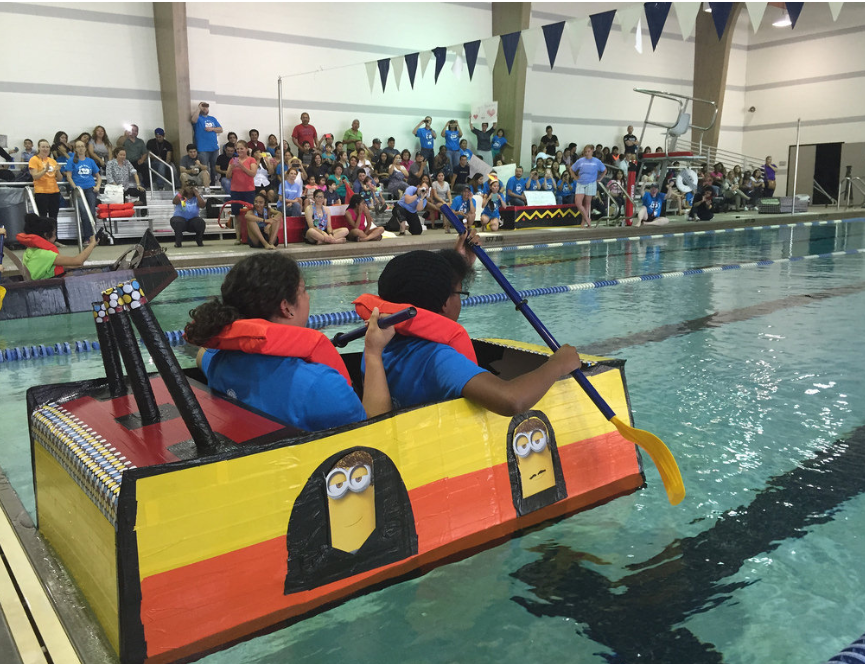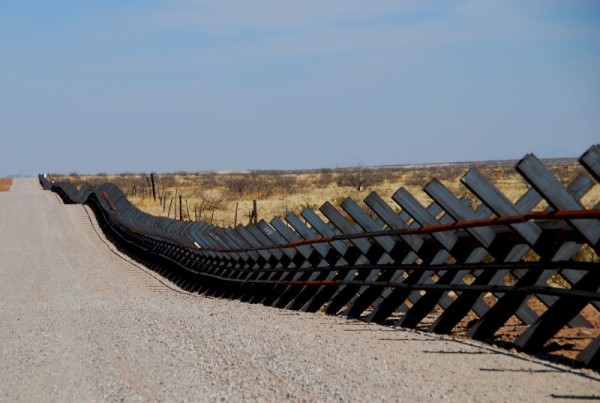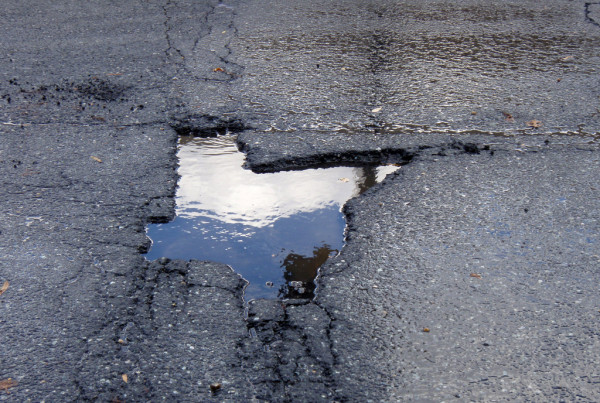This story originally appeared on Houston Public Media.
You might wonder how cardboard boxes, duct tape and a swimming pool can solve a problem that has stumped researchers for years.
That problem is how to get more women working in science, technology, engineering and math, or STEM for short.
Some think the answer lies in giving girls hands-on projects that spark their curiosity.
That’s where the tape, cardboard and pool come in. And why dozens of teenage girls recently gathered at the pool at Chavez High in southeast Houston.
They didn’t come to swim, if they can help it. They were prepping for an unusual regatta.
“We call it Mushu, for a dragon from Mulan,” said Jennifer Ochoa, 17, as she stood next to her canoe.
It’s dark red and the front looks like a dragon breathing fire.
She and her teammates built it with cardboard.
“And then we taped it with a lot of tape, just in case the water came in, and then we put another surface of cardboard to make it more, more fat and then we just started taping everywhere,” she explained.
That tape was supposed to keep it afloat.
“I’m really scared and nervous at the same time. I really want to win, but I mean I just want to have fun, too,” Ochoa said.
She further explained why she was nervous.
“Drowning or something? I don’t want to go in the pool because I’m scared for the water,” she said.
This regatta was the final challenge in their weeklong intensive STEM summer camp at Rice University’s Institute for Biosciences and Bioengineering.
It draws from several strategies to encourage girls to study and eventually work in STEM careers. Those include hands-on projects, creative challenges, collaboration and mentorships.
Before the regatta, coach Erin Russe laid down the rules.
“You’re starting in the shallow end, paddling to the deep end. If you’re one of the winners, you need to make sure to preserve your boat because you will be racing again in our finals round,” Russe said.
Dozens of parents, siblings and other students filled the bleachers at the indoor pool.
“So, who’s ready for some racing?” shouted Lisa Blinn, director of the program and the regatta’s emcee.
The twelve teams all had names, like the Yellow Submarine, Girls on Fire and S.S. Powder Puff.
They lugged their canoes to the shallow end. Two girls piled in each boat, grabbed their paddles, and then: “Three, two, one!”
At the whistle, they were off. Some girls struggled to stay on course. One team had to swim across the pool because their boat kept flipping over.
But this event was about much more than racing cardboard canoes.
It was about encouraging girls in STEM for the long haul. These fifty girls will participate in the Rice STEM initiative for three years.
Besides camp, they meet regularly with mentors – women who are making it in STEM.
It’s about building confidence and team-work.
These are some of the strategies recognized by national experts for girls in STEM.
“They’re more invested, they’re more interested, they’re more motivated when it’s something that relates to them and their lives and they can see it being valuable and meaningful,” said Brenda Britsch with the National Girls Collaborative Project.
Britsch said that it’s also important to give students feedback on their effort, and not innate ability.
Blinn, who directs the STEM initiative at Rice, said that before they did a lot of one-day camps and outreach. But she felt that they could make more impact with a more intensive and long-term program. That’s when the weeklong camp and multi-year mentorships started.
“We really believe that increasing women in the STEM pipeline is more about social justice and community building and community change than just exposing people to fields and showing them careers and telling them that are lots of jobs,” Blinn said, adding that girls need to feel like they belong in a certain job to pursue it and see role models.
At the regatta, team “Mushu” won. Student Alma Batres climbed out of her boat.
“My heart was racing, especially when we started to rear off from our path. I was like, ‘What do we do?!’ We had to paddle all at the same time for just a little while,” she exclaimed.
Alma’s mom, Antonia Adams-Batres, was a skeptic at first. But she cheered the whole time.
“I don’t believe this. And I’m so excited, I’m so shocked and amazed that these girls are so smart; they can do almost anything with anything,” she said.
Adams-Batres said that the race has taught her daughter how to work with others, and more.
“It really makes a point to everyone that women are intelligent, they are smart, they are innovative and they are on the rising scale to be as well, if not better as men,” she said.
Out in the workforce, women make up only 13 percent of engineers, according to the National Science Board.
For minority women, the numbers are even lower. They comprise fewer than one in every ten engineers and scientists, according to the National Center for Science and Engineering Statistics.
What’s puzzling about some of the statistics, however, is that in general girls are just as likely, if not more likely, to take advanced science and math as boys, said Jennifer Zinth, director of High School and STEM for the Education Commission of the States.
But on standardized tests, male students perform better.
“So people are wondering what’s at the root of all this, and how do we solve this, because it turns out that scholars don’t necessarily agree on the cause, and as a result we haven’t really found consensus on the most effective solutions,” Zinth said.
That hasn’t fazed Jennifer Ochoa, who’s 17 years old and from Honduras.
She said that she wants to work in bioengineering or the medical field.
“We all know that we can make it. It’s just that we need someone to push us and tell us, ‘Oh, you can do it!’” she said.
That’s her long-term goal. Today her goal was to win. And she did.
Here are seven strategies for engaging girls in STEM, according to SciGirls, a PBS television show and educational outreach program:
1. Girls benefit from collaboration, especially when they can participate and communicate fairly.
2. Girls are motivated by projects they find personally relevant and meaningful.
3. Girls enjoy hands-on, open-ended projects and investigations.
4. Girls are motivated when they can approach projects in their own way, applying their creativity, unique talents, and preferred learning styles.
5. Girls’ confidence and performance improves in response to specific, positive feedback on things they can control—such as effort, strategies, and behaviors.
6. Girls gain confidence and trust in their own reasoning when encouraged to think critically.
7. Girls benefit from relationships with role models and mentors.















